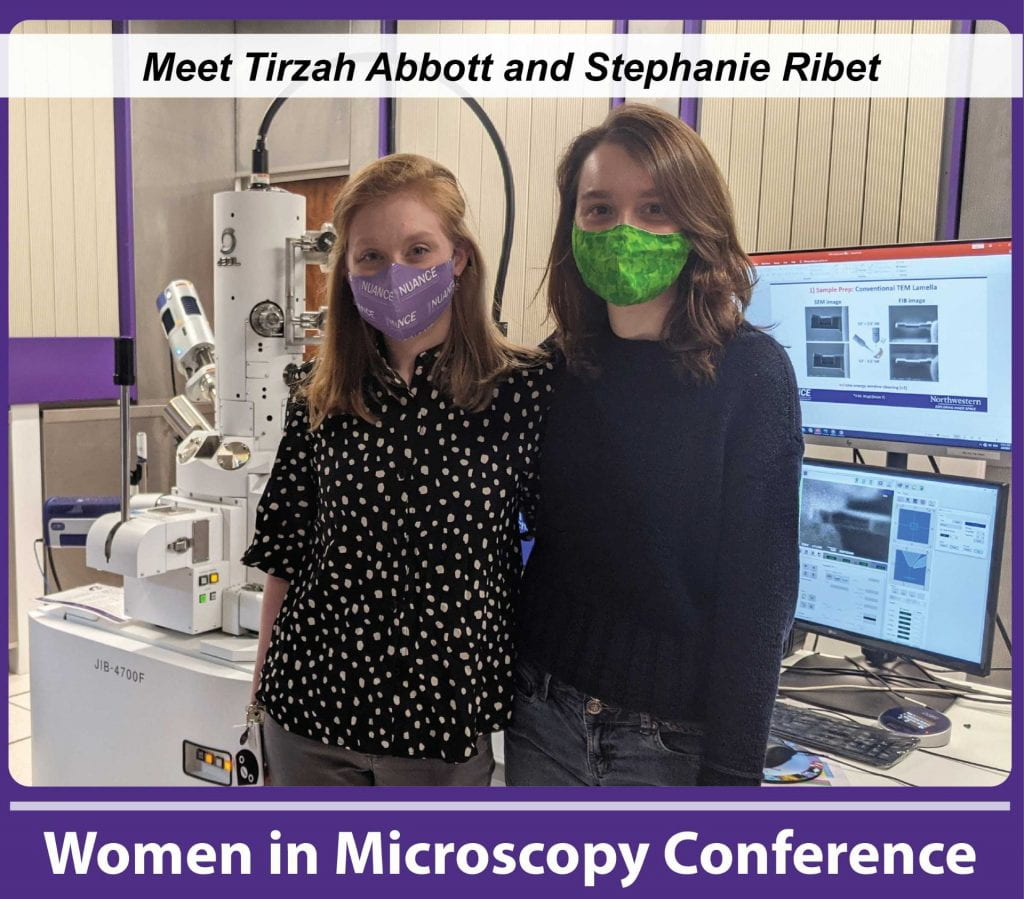Women researchers shine in science spotlight
More than a hundred attendees from around the world gathered virtually to celebrate International Women’s Day at the Women in Microscopy Conference. The event, co-hosted by Northwestern’s NUANCE Center, highlighted the work of female researchers, product specialists, and lab managers from universities, national labs, and microscope vendors.
 The half-day program (watch video) began with remarks from Deb Kelly, president of the Microscopy Society of America (MSA), and Vinayak Dravid, NUANCE director, who both highlighted the importance of diversity in STEM fields. The keynote speaker was highly successful microscopist, Dr. Ilke Arslan, director of the Center for Nanoscale Materials and the Nanoscience and Technology division at Argonne National Laboratory. She recounted her career and the contributions she’s made in many areas of electron microscopy, including tomography and in-situ electron microscopy, demonstrating how technique development in electron microscopy can lead to exciting new scientific discoveries. She concluded by talking about the new, cutting-edge research using ultrafast electron microscopy that she is currently leading.
The half-day program (watch video) began with remarks from Deb Kelly, president of the Microscopy Society of America (MSA), and Vinayak Dravid, NUANCE director, who both highlighted the importance of diversity in STEM fields. The keynote speaker was highly successful microscopist, Dr. Ilke Arslan, director of the Center for Nanoscale Materials and the Nanoscience and Technology division at Argonne National Laboratory. She recounted her career and the contributions she’s made in many areas of electron microscopy, including tomography and in-situ electron microscopy, demonstrating how technique development in electron microscopy can lead to exciting new scientific discoveries. She concluded by talking about the new, cutting-edge research using ultrafast electron microscopy that she is currently leading.
Novel research presentations at the conference featured the work of several successful postdoctoral scholars from across the United States and offered strong indication of the microscopy field’s future. The diversity of the discussion, drawing from various disciplines, proved that microscopy is a valuable tool in biology, astronomy, and other fields. The presentation from UIUC postdoctoral researcher Kayla Nguyen revealed howe new direct electron imaging techniques can help scientists understand magnetic and topological ferroelectric materials, while NUANCE 's own postdoctoral fellow Kun He showed how in-situ techniques can be used to study biomineralization of hydroxyapetite and oxidation of Cu catalysts. Juleen Dickson, a postdoctoral research associate at University of Wisconsin, Madison, presented her research on Cryo-electron tomography of platelet microtubules, which requires quick work with cold samples from mice. "It was so wonderful to meet and connect with so many extraordinary women and electron microscopists from national labs, academia, core facilities, and industry," said Dickson. "I had so much fun at this conference!"
Following the presentations , various career-oriented panel discussions focused on vendors and microscope development, facilities management, and research in federal labs and academia. Panelists all echoed the importance of following one’s research interests and being persistent.
"[The conference] is a nice blend of science with customer interaction, training, and education," said Jennifer McConnell, product manager for Protochips, one of the industry vendors participating. She, like others on the vendor panel, did not discover their love for microscopy until graduate school. However, all the panelists were incredibly passionate in developing cutting-edge tools to advance important research around the world.
The facilities managers who participated in the event were equally passionate about their work. Kathy Walsh of the University of Illinois, Urbana-Champaign, enthusiastically summed up her job as "the most fun parts of research, because I don’t have to worry about writing grant proposals or dealing with the reviewers." Daily tasks can include onboarding new users, assisting with instruments, and troubleshooting problems, such as broken hardware or issues related to software or data management.
The laboratory researchers who participated in the conference spoke about differences in culture between federal and academic labs, noting that each setting could vary in terms of how it approached competitive funding sources, work-life balance, and administrative workloads. However, both researchers agreed on the importance of networking. Sheri Singerling, postdoctoral research associate at the U.S. Naval Research Laboratory said, "I was honored to be invited to present my research and participate in a panel discussion and humbled to be in the (virtual) presence of so many brilliant researchers, facility managers, and microscopy-philes."
The conference was inspired by the desire to enhance female representation in the field, which historically has been sparse. "I noticed how many large conferences and workshops would only have one or two women presenting. We wanted to create a platform for women in microscopy to share their incredible research," said conference co-chair and NUANCE senior electron microscopy and imaging specialist Tirzah Abbott, who also spoke on the facilities management panel. Arslan spoke about this lack of diversity, mentioning how important a female perspective is for young microscopists because of the specific challenges women face. Work-life balance with kids, pay inequity, and "imposter syndrome" are some of the many obstacles women in STEM face, she noted, adding that these are not challenges they face alone. Many of the event speakers are mentors to the next generation of female researchers, facility managers, and vendors.
"It was incredibly inspiring to be in the presence of so many awesome scientists who I can identify with on a personal level," said conference co-chair and Northwestern doctoral student Stephanie Ribet of the Dravid Research Group. "In the past year we’ve seen more initiatives to celebrate and promote diversity in STEM. I hope that trend continues."